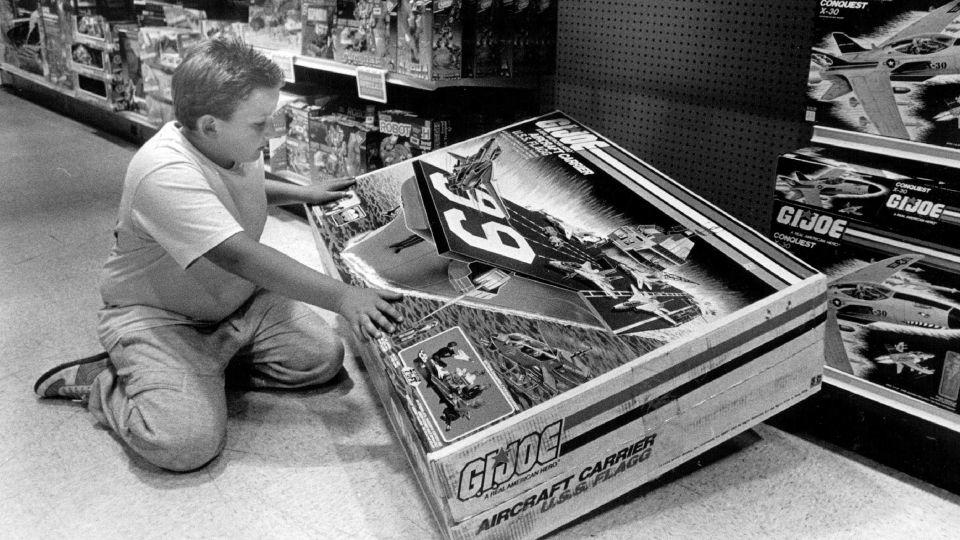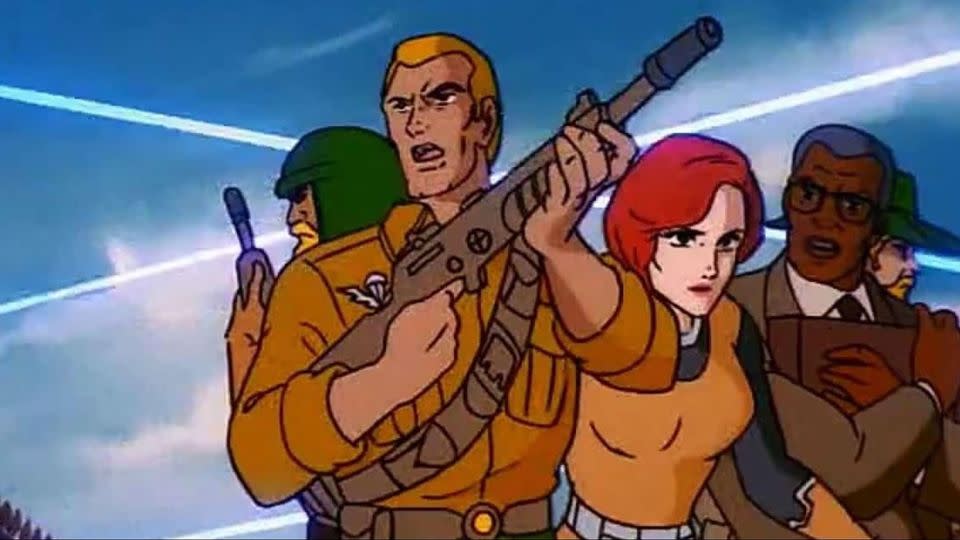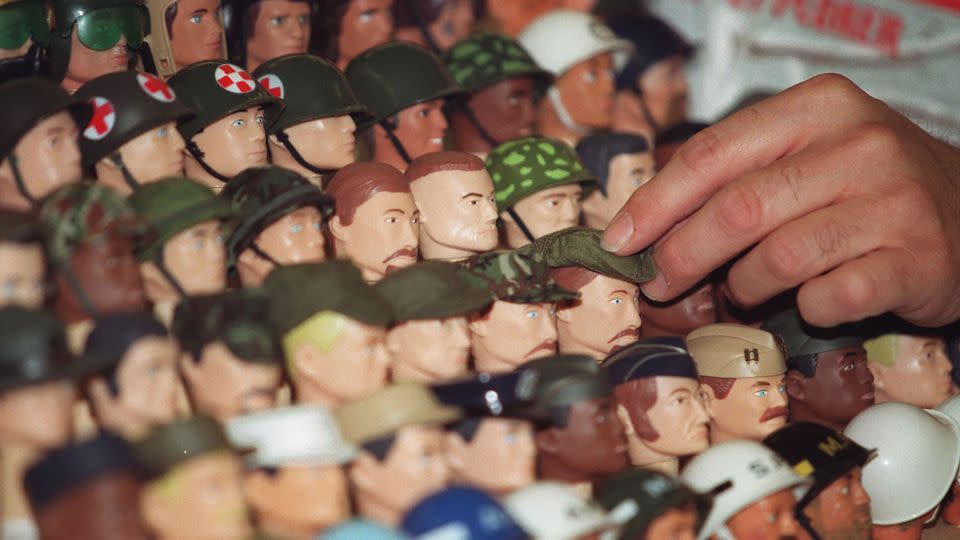Opinion: The big question as G.I. Joe turns 60
Editor’s Note: Roy Schwartz is a pop culture historian and critic. Follow him on Twitter, Instagram and Facebook and at royschwartz.com. The views expressed here are his own. View more opinion at CNN.
This month marks the 60th anniversary of G.I. Joe, first deployed into action in February 1964.

Like any good soldier, the all-American toy has always adapted to his terrain, reflecting a changing America. From early Cold War flag-waving to Reagan-era global adventurism to post-9/11 ambivalence, the iconic action figure has also served his country as a cultural historian. But how relevant is the sexagenarian war toy today? Do kids still play with G.I. Joes? And is that a good thing?
The answer is surprisingly complex, given the changing nature of America’s relationship with its own might, of notions of masculinity and of children’s playthings.
First tour of duty
The ultimate warrior was created to combat the fiercest enemy: Barbie. Since her introduction in 1959, Mattel’s fashion doll reigned supreme over the toy aisle. But dolls were strictly a girl’s toy. Even her boyfriend Ken was marketed for girls.
Like all toy companies, Rhode Island-based Hasselfeld Brothers (later abbreviated to “Hasbro”) wanted a boy’s equivalent, but the closest they got was Mr. Potato Head. Then, in 1963, came Stanley Weston. As a New York licensing agent, he understood the real money wasn’t in the doll, it was in the accessories and playsets. And as a Korean War veteran, he knew the military was a perfect source for both.
If a glamorous fashionista was every little girl’s fantasy, a rugged soldier would be every boy’s. Instead of different dresses, he would have different uniforms; instead of jewelry, he would have gear; instead of a pink purse, he would carry an M-1 semiautomatic.
Weston took the idea to Hasbro, where vice president and director of marketing and development Donald Levine loved it, then improved on it. Inspired by artist mannequins, Levine gave the doll joints that rotated and bent, allowing it to be played with and posed in a way that stiff dolls of the time couldn’t.
The problem was that back then, no red-blooded American boy would be caught dead playing with a doll, so they popularized a new term, “action figure.”

The first four recruits each represented a branch of the US military: an Army soldier, Navy sailor, Air Force pilot and Marine. The figure was named “G.I. Joe,” for “Government Issue Joe,” a World War II term for the common soldier.
G.I. Joe was released in February 1964, becoming an immediate hit. Over 16 million figures were sold by the end of the year. More variations followed — a green beret, a deep-sea diver, an astronaut — and in 1965 a Black Joe joined the roster, a rarity then, followed by an Army nurse in 1967.
For a generation of boys whose fathers and brothers fought in World War II and the Korean War, the appeal of G.I. Joe was unparalleled. In his second year of deployment, sales reportedly topped $36 million.
But despite G.I. Joe’s success, he was also criticized from the onset by parents and the press for glamorizing war. At the opening of the 1965 American Toy Fair in New York, peace groups protested with signs proclaiming “War Is Not a Game.” The following year, signs read “Toy Fair or War Fare?”
G.I. Joe debuted before American involvement in Vietnam intensified, but public sentiment toward the war soon turned negative. Wary retailers, notably Sears, dropped all war-related toys.
Attempts to redefine him as an adventuring environmentalist were met with tepid response, but what eventually did him in was real-world geopolitics. The 1973 oil crisis led the price of gasoline — including other petroleum byproducts like plastics for toys — to quadruple. It also coincided with a devaluation of the dollar. G.I. Joe was honorably discharged (or, in industry parlance, discontinued) in 1976.
Redeployment
By 1982, a new force had seized control over the toy market; Kenner’s Star Wars figures. G.I. Joe was once again called to duty, this time emulating Kenner’s 3.75” action figures, but with ten points of articulation instead of five. It was the perfect size for little hands and for fitting in vehicles and playsets.
But Kenner (which Hasbro acquired in 1991) had the advantage of blockbuster movies to promote its toys. So G.I. Joe was reconceived, from a theme-based figure to a story-based property. It was now, as the animated show’s opening would explain, “the code name for America’s daring, highly-trained special mission force. Its purpose: to defend human freedom against Cobra, a ruthless terrorist organization determined to rule the world.”
With the help of Marvel Comics, different characters were developed, each with a distinct backstory, personality, specialty, outfit and codename, like breakout character Snake Eyes, the silent ninja commando.
In June 1982 Marvel launched a comic series, “G.I. Joe: A Real American Hero,” which quickly became a top seller. It lasted 155 issues, until 1994, an impressive run for any non-superhero comic, especially a toy-based one.
The comic, as well as most of the “file cards” on the backs of the toy packages, were written by Larry Hama, a Vietnam vet. “A military comic was the last thing I wanted to do,” he said in a recent interview, but a gig was a gig. He made the comic more serious in tone than the PG cartoon, and it was praised for its surprising complexity and artistic innovation. He also used the final issue as an antiwar statement, with Snake Eyes writing, “there is no honor or glory in the primary occupation of the soldier … there is no winning.”

Hasbro then enlisted seasoned TV writer Ron Friedman to develop an animated show. Starting as two miniseries before segueing into ongoing syndication, “G.I. Joe: A Real American Hero” debuted in September 1983, catapulting the brand, and Hasbro, to new heights.
Friedman unabashedly based the show’s tone on his own worldview. Growing up in West Virginia, he regularly suffered from antisemitism, finding strength in comic books like Superman. It’s that sense of unflinching optimism that he brought to G.I. Joe, and which proved to be the show’s secret weapon. “If there is fear, there are champions out there to help you overcome it,” he told The Hollywood Reporter in 2016.
The show was criticized for its unrealistic, sanitized depiction of war, but Friedman also made sure it included messages of unity, inclusion and dedication to others. It was progressive, if not groundbreaking, in its inclusion and depiction of women and people of different ethnicities and backgrounds (Lady Jaye, for example, was realistically proportioned, fully clothed and highly capable).
The Joes and Cobra used laser guns, and no one was ever seriously hurt. Each episode ended with a moral or safety lesson by one of the Joes, where the famous catchphrase originates: “Now we know — and knowing is half the battle!”
The show struck a chord, and G.I. Joe went from a toy to a cultural phenomenon. The Iranian revolution and spread of militant terrorism, especially against American forces, made Cobra remarkably relevant. And the popularity of hypermasculine Sylvester Stallone and Arnold Schwarzenegger action movies made G.I. Joe their kid-friendly parallel. With more than 500 figures and 250 vehicles and playsets, the new G.I. Joe raised Hasbro’s stock price by 938% between September 1982 and September 1985.
New wars
By the mid-1990s, though, enthusiasm tapered off. Although Hasbro continued to release new G.I. Joe animated series and home video movies with corresponding toy lines, the Joes faced growing competition from rival action figures based on new shows. The X-Men, Power Rangers and Star Wars prequels, as well as ascendance of cable networks and video game consoles, relegated the proud soldier to the sale rack.
Then came 9/11, and American’s love-hate relationship with combat violence grew even more complicated. The attacks, and early days of the War on Terror, inspired renewed patriotism and a newfound appreciation for service people, but a team of American super soldiers fighting a zealot terrorist organization became a tough sell.
Like with Vietnam, as the wars in Afghanistan and Iraq dragged on, Americans steadily grew uneasy with romanticized depictions of combat and of American rectitude. When a G.I. Joe film was being considered at Paramount — championed by Stan Weston’s son, Brad, who was president of production — the Joes had to be recommissioned.
The 2009 movie, “G.I. Joe: The Rise of Cobra” changed G.I. Joe to mean “Global Integrated Joint Operating Entity,” an “international co-ed force of operatives who…battle Cobra, an evil organization headed by a double-crossing Scottish arms dealer.” Conservative pundits called it “anti-American.”
The movie missed the mark, bearing little resemblance to the familiar brand and failing to capture its uniqueness and spirit. It made just enough to produce a sequel, 2013’s “G.I. Joe: Retaliation,” and a reboot, “Snake Eyes,” in 2021, neither successful.
By 2004, Hasbro sold more than 400 million G.I. Joe action figures, according to the Strong National Museum of Play. It’s considered the most successful boys’ toy in history (the toy market is still highly gendered), and the figures’ quality is higher than ever.

But nowadays G.I. Joe is hard to find in stores. The brand seems to mostly rely on online sales to adult collectors, who are willing to spend on deluxe figures and statues to relive their childhood. Young boys, it appears, just aren’t interested anymore.
The obvious reason is Fortnite. Video games have supplanted action figures as boys’ favorite pastime, and militaristic games like Call of Duty and Halo scratch a similar itch to G.I. Joe.
But according to The Toy Association, the US toy market in 2023 was about $41 billion, a 26% growth compared to 2019, and action figures & accessories were almost $3 billion of that. Yet while Barbie remains a monopoly — it doesn’t have serious competition, the same as Lego and other interlocking bricks — G.I. Joe competes against many other action figures, predominantly superheroes and the evergreen Star Wars. (Hasbro, which last September celebrated its 100th anniversary, owns Transformers and the license to Star Wars and Marvel, so G.I. Joe may just not be a priority.)
There have also been several G.I. Joe video games over the years and, according to pop culture news site CBR, none have been successful. The problem seems to be with the brand itself.
“G.I. Joe more than any other product line has been a product of the influence of the social forces that surround it,” Derryl DePriest, vice-president of marketing for boys at Hasbro, told the BBC in 2014.
Since 1964, G.I. Joe has proven himself on every battleground imaginable, but can he successfully navigate today’s cultural minefield?
With contemporary notions of “toxic masculinity” (in 2019, the American Psychological Association issued guidelines to address “the pressure of masculinity ideology”), increased sensitivity to violence in children’s media, and anti-imperialist sentiment, as well as credence given to silly ideas like “Thomas the Engine” being an imperialist and “Paw Patrol” being authoritarian propaganda, does G.I. Joe even stand a chance?
Yes. What made G.I. Joe popular in the past is simple. Between the characters, accessories and playsets, it’s an endlessly versatile platform for a child’s imagination. It allows him — or her — to assume the role of the hero, in a way that a video game can’t quite match, even in first-person mode. An action figure is physical and inert, requiring active imagination and allowing full control over the play.
The fantasy at the core of G.I. Joe is bravery and friendship, just as powerful and relevant today. His glory days may be behind him, but what he needs to do is shed the nostalgia and focus on the future, keeping only his old unfailing optimism. He needs to reconnect with America — or maybe it’s the other way around — to know what his next mission is. And knowing is half the battle.
For more CNN news and newsletters create an account at CNN.com

